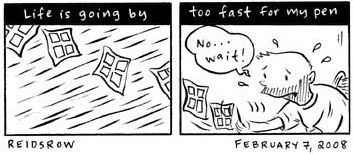Matthew Reidsma’s High Maintenance Machine is a diary comic that captures a moment from each day of his life. The webcomic has an intimate feel—Reidsma seldom uses more than six panels, and the focus is firmly on a few characters: Reidsma, his wife Wendy, and a handful of their friends. Sometimes the point of the comic is immediate and piercing, and other times it is obscure. Reidsma also collects his work into a monthly mini-comic that includes extras not found online.
Digital Strips: You say on your site that High Maintenance Machine began when you “kind of freaked out†on your 30th birthday. Can you explain a bit more about where it came from and how it fits into the rest of your life?
Matthew Reidsma: Whenever I thought of my long-term goals and aspirations I’d always say, “by the time I’m 30 I’ll do such-and-such.” When I turned 30, I couldn’t say that anymore, and I hadn’t done most of the things I told myself I would do. I wasn’t sure what I had done with those 30 years, so I felt like I needed a way to record the daily rhythm of my life. I tried keeping a written diary, but it didn’t feel right. Since I’d drawn comics about myself since I was a kid, I decided to get on the journal comic bandwagon. I set a goal of drawing a strip every day for a month, and posting them online. That was a year and a half ago.
Now the strip is as much a part of my day as eating. I get up every morning and draw my strip over a cup of coffee before heading to work. For me, drawing the strip, making the mini comics, and answering letters is meditative. If I’m too busy to keep up with the strips and I get behind, I feel terrible. When I go on vacation, I draw more than one strip a day because it makes me feel happy. Drawing the strip is the closest thing to a spiritual practice I have. (That sounds corny, but I went to Divinity School so I can say stuff like that.)
 DS: Has making this comic changed the way you view your own life? Do you catch yourself thinking “that would be a good comic?â€
DS: Has making this comic changed the way you view your own life? Do you catch yourself thinking “that would be a good comic?â€
MR: Well, I think I’m more reflective and aware of what is going on every day. At the beginning I thought constantly about what the comic would be for the day. I was hyper-aware of everything going on around me, constantly trying to cram my experiences into “panels” to see how they would work as comics. That lasted about two weeks, because that’s no way to live your life. Now, I don’t need to think much about the comic until I sit down to draw it. Sometimes I realize that an experience will be the comic for that day, but most of the time I just think over the day and pick something that I want to remember.
DS: How does your wife feel about being a character and having her intimate moments exposed to the world?
MR: She is supportive of the strip. I have a pretty good sense of what is appropriate to share, and if I ever have any question about something, I always run it by her first. She does find it strange when people she has never met think they know her.
DS: Your drawing style has evolved a lot since that first strip. Was that just because you were drawing every day, or were there other influences?
MR: Most of the changes are due to drawing every day, getting more comfortable with a brush, and knowing how I want to structure and pace my comics. I have made some conscious alterations to my drawing style, sometimes intentionally (shrinking my nose, changing Wendy’s hair) and sometimes because I changed brushes or started using a ruler. I try to draw famous paintings or pictures from magazines in my own style, something I picked up from reading Seth’s Sketchbooks. More than anything, that has helped define my style.
 DS: You present your comic in two very different ways: Standing alone on a web page, and grouped a month at a time in a mini-comic. Which do you have in mind when you create the comic, and how does the presentation affect it?
DS: You present your comic in two very different ways: Standing alone on a web page, and grouped a month at a time in a mini-comic. Which do you have in mind when you create the comic, and how does the presentation affect it?
MR: I don’t think of High Maintenance Machine as a web comic—I think of it as a little zine or mini-comic. I started putting it on the web for the accountability; if I get behind on the strips, I hear about it from other people. Sometimes I draw more than one diary strip in a day, and I run these bonus strips along with some extra stories, letters, and fan art in the mini comic. So when I think about the reader of the strip, I always think about the print version, even though only a small percentage of my readers ever see the mini-comic.

I just recently discovered Matt’s comics and love them! I spent an entire afternoon reading thru the entire backlog on his site and loved every minute of it. The coolest part was watching his style grow from the beginning to today.
matt’s comics are a wonderful subscription service!